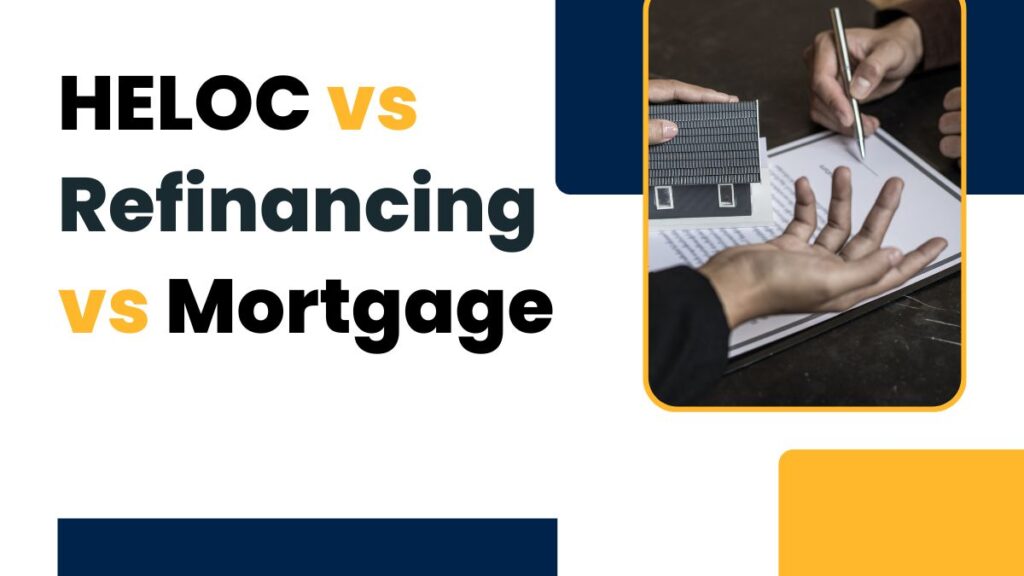Discover how to qualify for a Home Equity Line of Credit (HELOC). Learn about credit score, home equity, and income requirements to get started
A Home Equity Line of Credit (HELOC) allows you to borrow money using the value of your home. It’s like having access to a pool of funds when you need them most. But how do you qualify?
In this guide, we’ll cover the main factors lenders look at when deciding if you qualify for a HELOC, including:
Credit Score: Why your credit matters and how to improve it.
Debt-to-Income Ratio (DTI): How much debt you can afford and how to manage it.
Loan-to-Value (LTV) Ratio: How much of your home’s value you can borrow.
Home Equity: How lenders calculate the value you can access.
Income and Employment: The importance of stable income and job history.
By understanding these factors, you can improve your chances of qualifying for a HELOC. Ready to find out how? Let’s get started!
How to Qualify for a Home Equity Line of Credit (HELOC)?
To qualify for a HELOC, lenders evaluate several financial and property-related factors. Here’s what you need to know to prepare and improve your chances of approval.
Credit Score
Your credit score is one of the most important factors.
Good Credit Score (700-749): Higher chances of approval with competitive rates.
Excellent Credit Score (750+): Best interest rates and terms.
Why It Matters?
A higher credit score shows you’re financially responsible and less risky for lenders. A lower score could lead to higher interest rates or a declined application.
Steps to Improve
Debt-to-Income (DTI) Ratio
The DTI ratio compares your monthly debt payments to your gross income.
Ideal DTI: Below 43%.
Acceptable DTI
Some lenders may allow higher ratios, but lower DTIs are more favorable.
Why It Matters?
A lower DTI shows lenders that you have enough financial flexibility to handle additional debt.
How to Improve DTI
Loan-to-Value (LTV) Ratio
The LTV ratio measures how much of your home’s value is tied to loans.
Target LTV: 80% or lower is typically required.
Why It Matters?
A lower LTV ratio means you have more equity in your home, which gives lenders confidence that they can recover their funds if needed.
How to Calculate LTV?
Loan-to-Value (LTV) Formula:
LTV =
(Mortgage Balance + HELOC Amount)
—————————-
Appraised Home Value
Example
If your home is worth $400,000 and your mortgage balance is $250,000, your LTV is 62.5%.
How to Improve LTV?
Make additional payments toward your mortgage to reduce the balance.
Increase your home’s value with renovations or upgrades.
Home Equity
Home equity is the difference between your home’s market value and your mortgage balance.
More Equity = Higher Borrowing Power.
Example
A home worth $500,000 with a $300,000 mortgage balance has $200,000 in equity.
Why It Matters?
Lenders often allow you to borrow up to 80%-90% of your equity. A higher equity amount gives you access to larger credit lines.
Tips: Make extra mortgage payments to pay down the principal faster. Keep your home well-maintained to retain or increase its market value.
Income and Employment Stability
Stable income is critical for demonstrating your ability to repay the HELOC.
Required Documents
Pay stubs, W-2s, tax returns, or employment verification letters.
Self-Employed Individuals
Provide additional paperwork like business financial statements or 1099 forms.
Why It Matters?
Lenders look for steady income over the past two years. Job changes or inconsistent income may raise concerns.
Tip: If you’re self-employed, show consistent income and build a strong savings history to reassure lenders.
Property Type and Condition
The type and condition of your home impact eligibility.
Preferred Properties: Single-family homes and primary residences.
Condition Matters: A well-maintained home with no structural issues is more likely to qualify.
Why It Matters?
Lenders use your home as collateral for the HELOC. Homes in poor condition or with lower appraisal values may limit borrowing options.
Savings and Emergency Fund
Having savings or an emergency fund shows financial preparedness.
Why It Matters?
It demonstrates to lenders that you can handle unexpected expenses and continue making payments during financial challenges.
Tip: Build a cushion of 3-6 months’ worth of living expenses before applying.
Purpose of the HELOC
Lenders may inquire about how you plan to use the funds.
Acceptable Uses: Home improvements, education, debt consolidation, or other investments.
Avoid Risky Uses: Speculative investments or non-essential purchases.
Why It Matters?
Responsible plans show lenders that you’re using the HELOC wisely, making them more likely to approve your application.
Compare Lenders and Terms
Different lenders offer varying requirements, rates, and benefits.
Why It Matters
Shopping around can help you find better interest rates, lower fees, and flexible repayment options.
What to Look For?
Gather Required Documents
Being prepared with the necessary paperwork speeds up the application process.
Typical Documents
Why It Matters?
A complete application reduces delays and increases your chances of approval.
Improving Your Chances of Qualification
Here are practical ways to increase your chances of getting approved for a home equity line of credit (HELOC):
Improve Your Credit Score
Your credit score plays a big role in qualifying for a HELOC and securing better rates.
How to Improve?
Lower Your Debt-to-Income (DTI) Ratio
A low DTI shows lenders you can handle the new debt.
How to Improve?
Build More Home Equity
The more equity you have, the better your chances of qualifying and borrowing more.
How to Build Equity?
Gather All Necessary Documents
Having your paperwork ready can make the application process smoother.
What You’ll Need?
Maintain Stable Employment
Lenders prefer applicants with consistent income.
How to Show Stability?
Stay in your current job for at least two years before applying.
If self-employed, provide extra documentation, like business income statements or tax records.
Compare Lenders
Not all lenders offer the same terms, so shop around.
What to Compare?
Save for Unexpected Costs
Having savings shows financial stability and can make lenders more confident in your application.
Apply at the Right Time
Timing can impact your approval and loan terms.
When to Apply?
By following these steps, you can make yourself a stronger candidate for a HELOC and improve your chances of approval. If you need more details or have questions, feel free to ask!
Home Equity Line of Credit Canada New Rules
The Canadian government introduced major changes to mortgage rules in 2024 to make buying a home easier for Canadians. Find out how these new rules for Home Equity Lines of Credit (HELOC) could impact you.
Key Changes
Have a close look at the key changes:
Higher Insured Mortgage Cap
Starting December 15, 2024, the limit for insured mortgages will increase from $1 million to $1.5 million. This helps more Canadians qualify for mortgages with a smaller down payment.
Longer Amortization Periods
First-time buyers and those purchasing new builds can now get 30-year mortgage terms, starting December 15, 2024. This reduces monthly payments, making homeownership more affordable.
Easier Lender Switching
From November 21, 2024, borrowers can switch lenders at renewal without requalifying under strict rules, as long as the loan amount and schedule stay the same. This encourages better rates and competition.
These reforms are part of Canada’s effort to improve housing affordability and help more people achieve their dream of owning a home.
Home Equity Line of Credit Rates Canada
As of January 2025, HELOC rates in Canada are usually variable, based on the lender’s prime rate plus a small margin. Rates typically start around 5.35% to 5.95%, depending on the lender and your financial profile.
Talking to a financial advisor can help you understand your options better.
How AJP Mortgage Can Help?
Need access to cash? AJP Mortgage can help you get a HELOC Home Equity Line of Credit with a simple process and fast approval. Use your home’s value for home improvements, debt, or other expenses.”
Understand Your Finances
Before applying for a Home Equity Line of Credit (HELOC), it’s important to understand your financial situation. We’ll help you take a look at things like your income, credit score, and current debts. This will not only show you where you stand but also help you improve your chances of getting approved for a good HELOC rate.
Find the Best Lenders
We work with top lenders to find the best HELOC options for you. Different lenders offer different terms and interest rates, so we make sure to connect you with the best deal based on your financial situation.
Support Throughout
We’re here to guide you through the entire HELOC process. We’ll answer your questions, explain the details, and make sure you understand everything clearly. Our goal is to make the process smooth and simple for you.
Make It Simple
HELOCs can seem complicated, but we’ll break it down into simple terms. We’ll explain how it works, how the rates are set, and what the repayment process looks like. This way, you can make an informed decision without feeling overwhelmed.
Access Your Home’s Equity
A HELOC allows you to borrow money based on the equity you’ve built in your home. Whether you need funds for home improvements or to pay off debt, we’ll help you access your home’s equity in the easiest and most cost-effective way.
Maximize Your HELOC
Once you have a HELOC, it’s important to use it wisely. We’ll share tips on how to manage your HELOC, such as keeping your balance low and making regular payments. This will help you save money and avoid unnecessary fees.
Personalized Help
Everyone’s situation is different, so we provide advice that’s tailored to you. Whether you’re a first-time borrower or looking to refinance, we’ll help you find the right solution for your needs.
With our help, you can confidently access a HELOC that works for you and use it wisely to reach your financial goals.
Case Studies
See how AJP Mortgage has helped real clients achieve their goals. Explore our case studies to learn how we’ve made home financing easier and more accessible for homeowners like you
Case Study 1: First-Time HELOC User
Situation: Sarah wanted to fix up her home but didn’t have enough savings.
How We Helped: We helped Sarah understand her finances and qualified her for a HELOC. We also connected her with the right lender.
Result: Sarah used her home equity to fund her home renovations and is now paying off the loan with lower interest rates.
Case Study 2: Consolidating Debt
Situation: Tom had high-interest credit card debt and wanted to reduce his payments.
How We Helped: We helped Tom use his home equity to pay off his credit cards and lower his interest rates.
Result: Tom now has one easy monthly payment and is saving money on interest.
Case Study 3: Buying a Second Property
Situation: Emma wanted to buy a vacation home but didn’t have enough saved up.
How We Helped: We helped Emma access her home equity and connected her with a lender offering a good rate.
Result: Emma bought her vacation home and is paying off the HELOC with affordable payments.
At AJP Mortgage, we help people like Sarah, Tom, and Emma use their home equity for different needs like home improvements, debt consolidation, or buying a second property. If you’re ready to learn more, contact us today!
Final Verdict
Qualifying for a Home Equity Line of Credit (HELOC) can help you access funds for things like home improvements or consolidating debt. By understanding your financial situation and meeting lender requirements, you can increase your chances of qualifying for a good deal.
Key Takeaways
Check Your Home Equity: Make sure you have enough equity in your home.
Credit Score Matters: A good credit score is important for qualifying for better rates.
Income and Debt: Lenders will look at your income and existing debt.
Compare Lenders: Shop around to find the best HELOC rates and terms.
Interested in learning more about HELOCs? Contact AJP Mortgage today to get expert advice and find the best option for you!
Frequently Asked Questions
Is it hard to get an equity line of credit?
It depends on your finances. If you have good credit, enough home equity, and steady income, it’s easier. If not, it could be harder.
What credit score do you need for a home equity line of credit?
Most lenders want a credit score of at least 620. A higher score (700+) can help you get better rates.
What is the monthly payment on a $50,000 home equity line of credit?
Payments vary, but with a 5% interest rate and a 20-year term, it could be around $350–$400 per month.
How much equity do you need to get a line of credit?
You typically need 15%–20% equity in your home. For example, with a $200,000 home, you’d need $30,000–$40,000 in equity to qualify. More equity helps!


